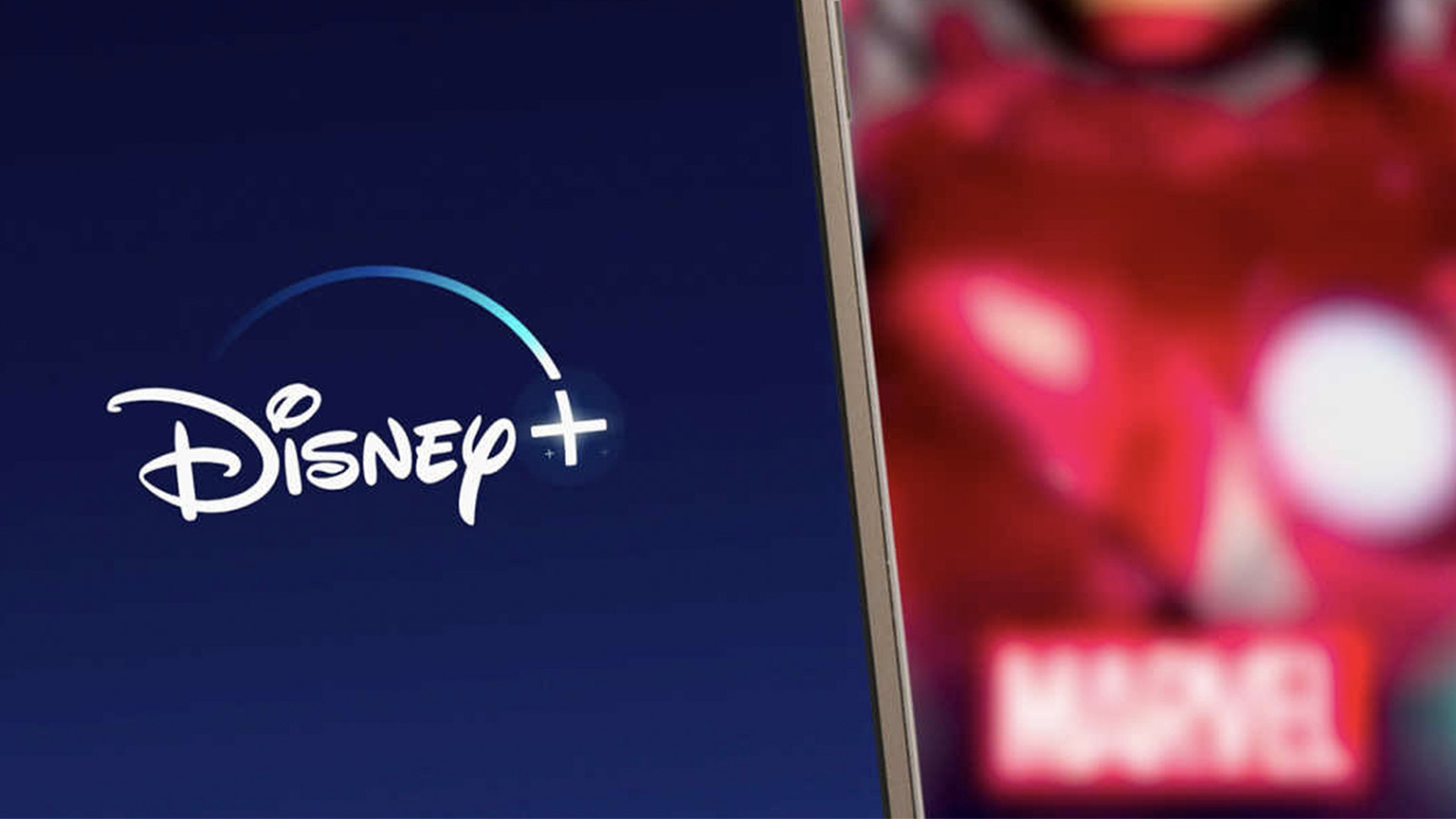One of the largest tourism companies in the world is The Walt Disney Company. Disney is the most successful global company tourism operator – everyone has heard of them! But their success didn’t just happen overnight and later we will look at how much they have grown over the last century.
Today, the Walt Disney Company (WDC), together with its subsidiaries and affiliates, is a leading diversified international family entertainment and media enterprise with four business segments, which are:
- Disney Parks, Experiences, and Products
- Disney Media & Entertainment Distribution
- Studio Entertainment
The following table illustrates the international content operations of the Walt Disney Company (WDC).
Explore: Disney Company Overview
| Disney Parks, Experiences & Products |
|
| Disney Media & Entertainment Distribution | (Streaming services)
|
| Studio Entertainment |
|
| Disney International Content & Operations | This segment develops, produces and distributes content for programming outside of the U.S. |
Disney Parks, Experiences, and Products, (DPEP) are responsible for creating magical memories around the world through their brands and franchises including – Disney, Pixar, Marvel, Star Wars, ESPN, Twentieth Century Studios, and National Geographic.
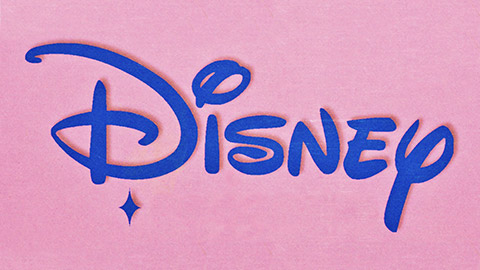
When Walt Disney opened Disneyland, (California) on July 17, 1955, he created a unique destination built around storytelling and immersive experiences, ushering in a new era of family entertainment. More than 60 years later, DPEP has grown into one of the world’s leading providers of family travel and leisure experiences. Disney’s magic is created by a team of ‘Imagineers’ and is shared across 6 resort destinations with 12 theme parks and 53 resorts spread over the U.S.A., Europe and Asia, 4 cruise ships, (with plans for 3 more by 2025), a family beach resort in Hawaii and two guided tour adventure businesses.
DPEP also encompasses Disney Consumer Products, Games and Publishing. Products include games, toys, clothing, books, and even fine art. The Walt Disney Company (WDC) is not only one of the world’s biggest licensors of games and consumer products but one of the largest children’s publishing brands globally. They reported $54 billion in retail sales worldwide of licensed products in 2021. (Loveday, 2021)
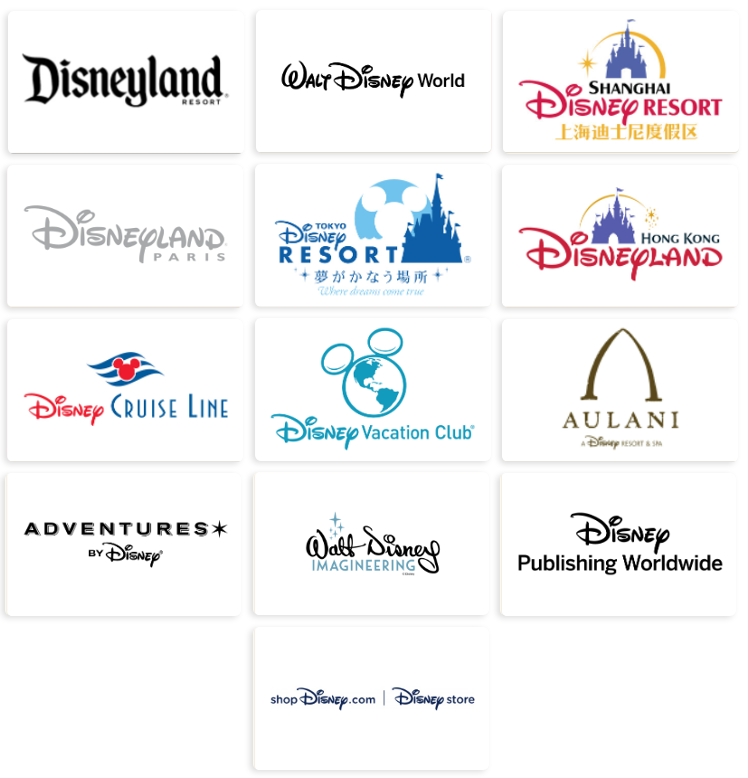
Disney Media & Entertainment Distribution
Disney Media & Entertainment Distribution, (DMED), comprises of various streaming services which provide direct-to-consumer products. DMED combines media distribution, technology and advertising sales and manages operations of the WDC’s streaming services.
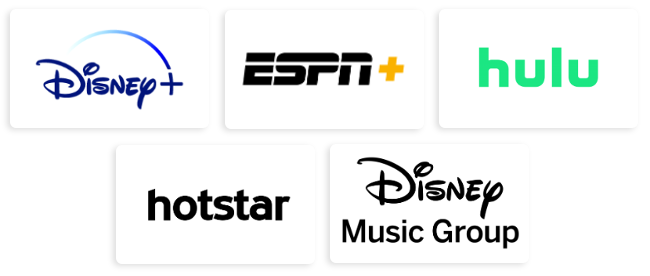
Studio Entertainment
For over 95 years, The Walt Disney Studios has been the foundation on which the Walt Disney Company was built. Today, the Studio Entertainment segment brings quality movies, episodic series, music and stage shows to consumers throughout the world. Feature films are released under the following banners: Disney, including Walt Disney Animation Studios and Pixar Animation Studios, Marvel Studios, Lucasfilm, 20th Century Studios and Searchlight Pictures. The Disney Theatrical Group produces, and licenses live events, including Disney on Broadway, Disney On Ice and Disney Live!
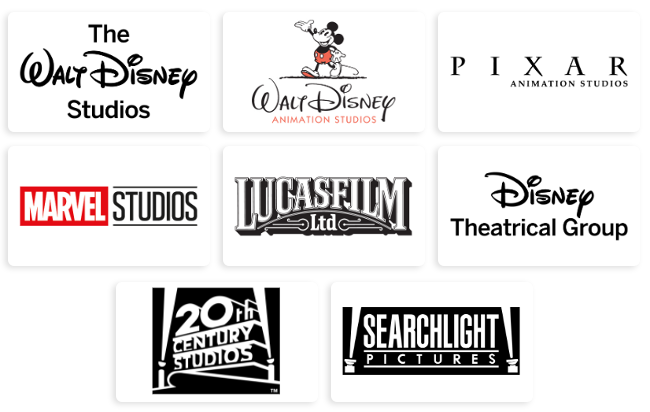
International Content And Operations
The International Content and Operations group is responsible for developing and producing local and regional entertainment and sports programming outside of the U.S. for the WDC’s streaming platforms. It’s made up of teams across the Asia Pacific regions, Europe, the Middle East and Africa, India, and Latin America. They manage Disney’s businesses and operations in these areas along with local advertising sales and distribution.
Reading
Check out the Disney Parks Blog. There are lots of resources that you can access to increase your knowledge of the parks.
Learning Activity: Disney Theme Parks
The Disney Theme Parks are shown in the image. Click on each icon to learn more about each park. The locations have been deliberately left out of the descriptions!
Name the locations from the interactive map, and post a screenshot of the map to illustrate your answers in a Forum post, Disneyland Locations.
Having looked at the business segments and revenues of the WDC, you’re aware of how successful they have become. But to appreciate how the company achieved its success, we need to look at the history of how it all began. The history of the WDC starts with the man himself, Walt Disney.
Watch this video
It is the Walt Disney story. (21:53)
Take notes while watching the video clip of anything you feel is significant about Walt Disney himself or events that contributed to the development of the company.
Read the following abridged excerpt from Benjamin Barber’s piece on Disneyland History. (Barber, 2019)
Reading: Disneyland History
Construction for the original theme park, Disneyland, (Anaheim, California) began on July 21, 1954, a meagre 12 months before the park was scheduled to open. From that day forward Walt Disney's life would never be the same. The design of Disneyland was something never done before. There had certainly been other amusement parks, but none with the magical storytelling element and attention to detail that Walt Disney wanted to create. His vision was to give families a total, and unique experience.
Some 160 acres of citrus trees had been cleared and 15 houses moved to make room for the park. The area was in semi-rural Orange County near a freeway that would eventually stretch from San Diego to Vancouver.
When the real designing came around Walt was met with inevitable questions. How do you make believable wild animals that aren't real? How do you make a Mississippi paddle ship? How do you go about building a huge castle in the middle of California? So, Walt Disney looked to his movie studio staff for the answers. There would be five uniquely different lands.
Walt had planned out all the lands, to every detail. Main Street, U.S.A., the very front of the park, was where Walt wanted to relive the typical turn-of-the-century city Main Street. He said:
"For those of us who remember the carefree time it recreates, Main Street will bring back happy memories. For younger visitors, it is an adventure in turning back the calendar to the days of grandfather's youth."
Walt made Main Street U.S.A. the entrance to a "weenie," as he called it. He said:
"What you need is a weenie, which says to people 'Come this way.' People won't go down a long corridor unless something is promising at the end. You have to have something that beckons them to 'walk this way.'
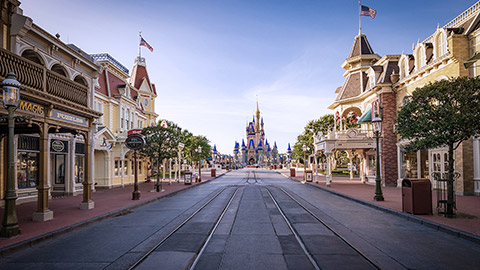
Walt Disney also had planned for an "exotic tropical place" in a "far-off region of the world” called Adventureland. He said, "To create a land that would make this dream a reality we pictured ourselves far from civilization in the remote jungles of Asia and Africa."
Frontierland was made to relive the pioneer days of the American frontier. Disney said:
"All of us have a cause to be proud of our country's history, shaped by the pioneering spirit of our forefathers. Our adventures are designed to give you the feeling of having lived, even for a short while, during our country's pioneer days."
Fantasyland was created to "make dreams come true" from the lyrics of "When You Wish Upon a Star." He said:
"What youngster has not dreamed of flying with Peter Pan over moonlit London, or tumbling into Alice's nonsensical Wonderland? In Fantasyland, these classic stories of everyone's youth have become realities for youngsters of all ages to participate in."
Fantasyland would feature a large Sleeping Beauty Castle (as seen below) and a Fantasy Village.
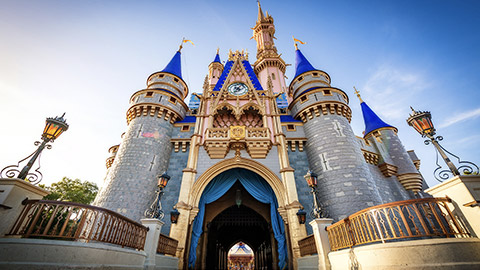
Tomorrowland was created as a look at the "marvels of the future." Dinsey stated:
"Tomorrow can be a wonderful age. Our scientists today are opening the doors of the Space Age to achievements that will benefit our children and generations to come. The Tomorrowland attractions have been designed to allow you to participate in adventures that are a living blueprint of our future."
Although Walt Disney had trouble working on Tomorrowland. He said, "Right when we do Tomorrowland, it will be outdated."
Disney kept close to every detail of the park's construction, and he visited the site in Anaheim several times a week. Progress went sporadically despite exasperating obstacles.
Reflection
Do you think Walt Disney was right to state that Tomorrowland would be outdated as soon as it was completed?
Consider if you think it is a product of its time.
How could the company address this issue in the future?

The Rivers of America carved out of sandy citrus grove soil, refused to hold water. The answer was finally found in a bed of native clay: an inch-thick layer on the riverbed formed a pad as hard as cement. Although minor setbacks did follow, progress did continue.
Plants were planted throughout the park, emptying nurseries from Santa Barbara to San Diego. The detail was made; if Walt Disney didn't like what his studio designers came up with, he'd do it himself. An example of this is Tom Sawyers Island. He thought his designers had "misunderstood the idea" so Walt took home the plans and the next day had it designed the way it appears today.
Bit by bit, Disneyland got ready for Grand Opening Day. The staff worked around the clock to get ready. The Mark Twain paddle ship was being moved, deck by deck, down the Santa Ana freeway to get to Disneyland on time. Finally, everything seemed to come together. The "magical little park" was a $17,000,000 "Magic Kingdom. "Walt's dream had come true and Disneyland was ready to open."
The excitement of the opening of Disneyland was such that it was covered on television and many celebrities attended. Despite extensive planning, much went wrong. There are many lessons that were learned from that day that have gone on to contribute to other companies’ risk management planning and success. The following is taken from ‘Designing Disney’
After one full year of rigorous construction demands and a total investment of $17 million, the gates of Disneyland opened for its first guests on Sunday, July 17, 1955, 14h EDT. A special 'International Press Preview' event was held, which was only open to invited guests.
Six thousand invitations to the Grand Opening had been mailed to studio workers, construction workers, the press, and officials of company sponsors.
- Parking Pass from the opening of Disneyland in 1955
- Memo from Walt Disney describing the opening of Disneyland in 1955
- Walt Disney and Mickey Mouse at the opening of Disneyland in 1955
(All images courtesy of https://www.oscars.org/news/magical-trip-disneyland)
At the time, it was one of the largest and most complex live broadcasts ever. Ninety million viewers watched the coverage of the unveiling of the world’s most fabulous kingdom.
On day one, Disneyland Park offered five themed 'lands' with a total of 20 attractions across Adventureland, Frontierland, Fantasyland, Tomorrowland, and Main Street USA.
But as the gates opened, all was not quite ready. Workmen were still planting trees, and, in some areas, the paint was wet to the touch. The asphalt on Main Street USA that had been poured just that morning was so soft that the spiked heels on the woman’s shoes sank in.
The event did not go smoothly. The park was overcrowded as the by-invitation-only affair was plagued with counterfeit tickets. Only 11,000 people were expected to show up, but by mid-afternoon, over 28,000 ticket holders were heading for Disneyland, causing unprecedented traffic jams.
Southern California was suffering from a record heat wave with temperatures of over 100 degrees Fahrenheit and a plumbers' strike left many of the park's drinking fountains dry. Rides broke down shortly after opening and restaurants and refreshment stands ran out of food and drink. A gas leak in Fantasyland caused Adventureland, Frontierland, and Fantasyland to close for the afternoon.

During the event, Walt Disney didn’t know about all the things that were going wrong. His attention was consumed by the 'Dateline Disneyland' live broadcast. It wasn’t until the following day that he became aware via press accounts of what had happened.
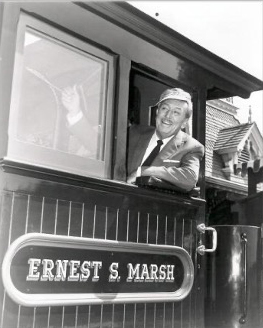
Walt and his staff immediately took the necessary measures to deal with the problems of low ride capacity, congested walkways, traffic jams, and slow food service. The press was invited back for a private "second day" to experience the true Disneyland.
Disneyland Park opened to the public on Monday, July 18, 1955, at 10 a.m. By 2 o’clock in the morning, people were already lining up outside the park’s gates. The first person to buy a ticket and enter the park was David MacPherson. He got admission ticket number two, as Roy O. Disney arranged to pre-purchase ticket number one.
Walt Disney had an official photo taken with two children, Christine Vess Watkins and Michael Schwartner. (Bogaert, 2022)
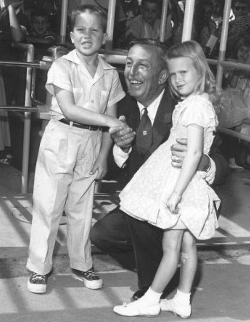
Today, more than 65 years later, Disneyland has become a cultural phenomenon. Walt Disney’s legacy lives on in the company he started which grew into the global giant we know today.
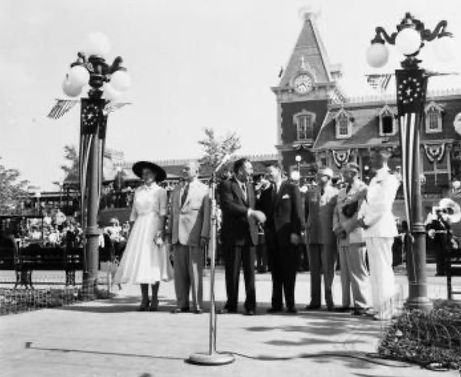
Disneyland’s disasters were numerous that day, but they held important lessons for all companies.
Reading
Check out the Disney Park History Links where you can also find vintage photos and interesting commentary on several blogs.
Learning Activity: A Disastrous Opening
On reflection on how Disneyland managed its opening, write down three areas that went wrong and what other tourism companies could learn from this. Here is an example of what is needed in this activity.
Example 1: As a result of the counterfeiting, instead of the opening crowd of 8,000 – 11,000 expected, almost 28,000 showed up at the park according to Martin Sklar, Vice Chairman of Walt Disney Imagineering. With a near 100% increase over expected volumes, you can imagine the stress on the employees, the infrastructure, and the overall experience that day.
Action: Plan for the unexpected on your launch day, be ready for more than you anticipate, and be flexible in how you respond. Have contingency plans for things that might go wrong.
Post your own three responses to the Forum, A Disastrous Opening.
In California today, there are two Disney theme parks:
The latter theme park is next to Disneyland, and you can walk between the two parks, and it takes just a few minutes with no roads to cross.
Downtown Disney is also situated within easy walking distance and offers shopping, dining, and entertainment. There are over 15 places to eat and over 20 retail shops including the mega-sized Disney Store in which you can spend hours looking at all the Disney merchandise.

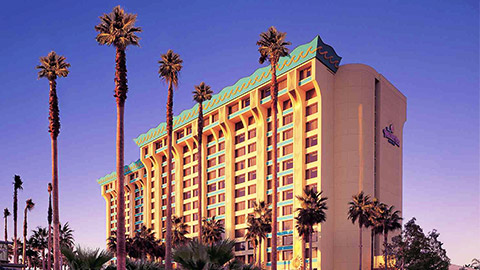
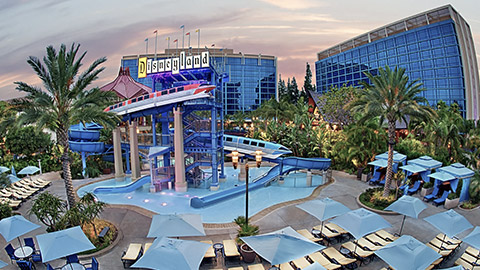
In 1959, Walt Disney Productions began looking at areas for a second park. This was driven by results from market surveys as well as Walt Disney’s desire to control a much larger area of land to prevent the startup of competitors. These surveys revealed that only a tiny portion of the United States population went to Disneyland due to where the park was positioned. The search in Florida began!
Walt Disney was impressed with the Orlando planning – a large state highway, international airport, and well-structured road layout – and decided that Orlando would be home to the next Disney Park.
It was sneaky the way Walt Disney Productions bought the land.
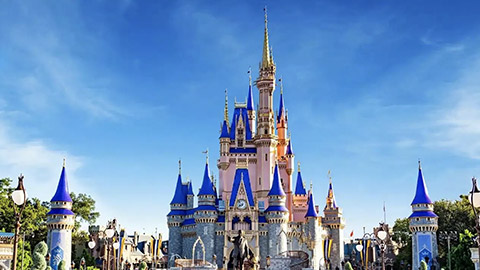
Walt Disney Productions set up several fake companies to buy the land from the various owners so that they would get enough land without people protesting! Tricky! Once the newspapers discovered this and leaked the story, Walt Disney and his production team gave a press conference explaining the dream they had for the area they now owned. The dream was bought, and the area gave Walt Disney Productions the power of an incorporated city!
The Magic Kingdom was the first park to be built and was designed to be a bigger version of Disneyland. Magic Kingdom is just one of 4 theme parks and 2 water parks on the Disney World site. Overall, Walt Disney World Florida covers over 27,000 acres, whereas Disneyland and California Adventure in Anaheim is compact with only 500 acres of land area.
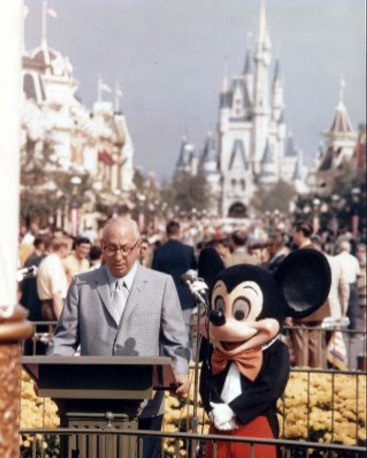
When the Magic Kingdom opened, two Disney hotels opened at the same time: Disney's Contemporary Resort (with the monorail running through it) and Disney's Polynesian Resort. The park opened with 23 attractions, three unique to the park and 20 copies of attractions at Disneyland.
Cinderella's Castle stands 189 feet tall--100 feet taller than the castle in Disneyland in California--but the Florida counterpart appears even taller due to "forced perspective" that is used on most of the buildings in the Magic Kingdom. As the building gets taller, its width gets smaller, which gives those looking up the feeling that the building is higher than it is.
Unfortunately, Walt Disney died before construction could begin. The Disney Production team completed the project from the designs Walt had created and the park was opened on 1 October 1971.
Watch This video
It will expand your knowledge of Walt Disney World. (1.08:05)
LEADING WORLDWIDE AMUSEMENT & THEME PARKS BY ATTENDANCE IN 2019 AND 2020 (in millions)

Watch this video
It is a compilation of Disneyworld vacation planning. (49:31)
Explore
Use the links below to visit the Walt Disney World website and an interactive map of Walt Disney World. For your development conduct general research and answer the questions that follow. You can also check out some YouTube clips to experience some of the features.
The WDC’s corporate social responsibility report reveals its vision and details its commitment to operate responsibly and ethically.
Answer the following interactive questions, before you address the three questions in the learning activity below:
Learning Activity: Walt Disney Report
Answer the following questions. They are designed to improve your knowledge of sustainability in the Walt Disney Company.
- What are the WDC’s 2030 environmental sustainability goals in terms of emissions?
- Specifically, what has the company implemented that contributes to water conservation?
- What is Disney Castaway Cay in the Bahamas?
Watch the following video about Castaway Cay in the Bahamas. (18:24)
Post your responses to these questions in the Forum, Walt Disney Report.
The Mission
‘The mission of The Walt Disney Company is to entertain, inform and inspire people around the globe through the power of unparalleled storytelling, reflecting the iconic brands, creative minds and innovative technologies that make ours the world’s premier entertainment company.’
This mission statement provides the company’s future intent whilst directing and encouraging its employees about their place in the company and how their actions impact on the future business success.
Disney’s primary purpose is entertainment, and this is clearly shown in the mission statement, but it also sends out a clear message that it is focusing on leading the entire industry by stimulating positive change.
Values
Disney presents its values in the form of ‘The 5 Keys’. These are specified below.
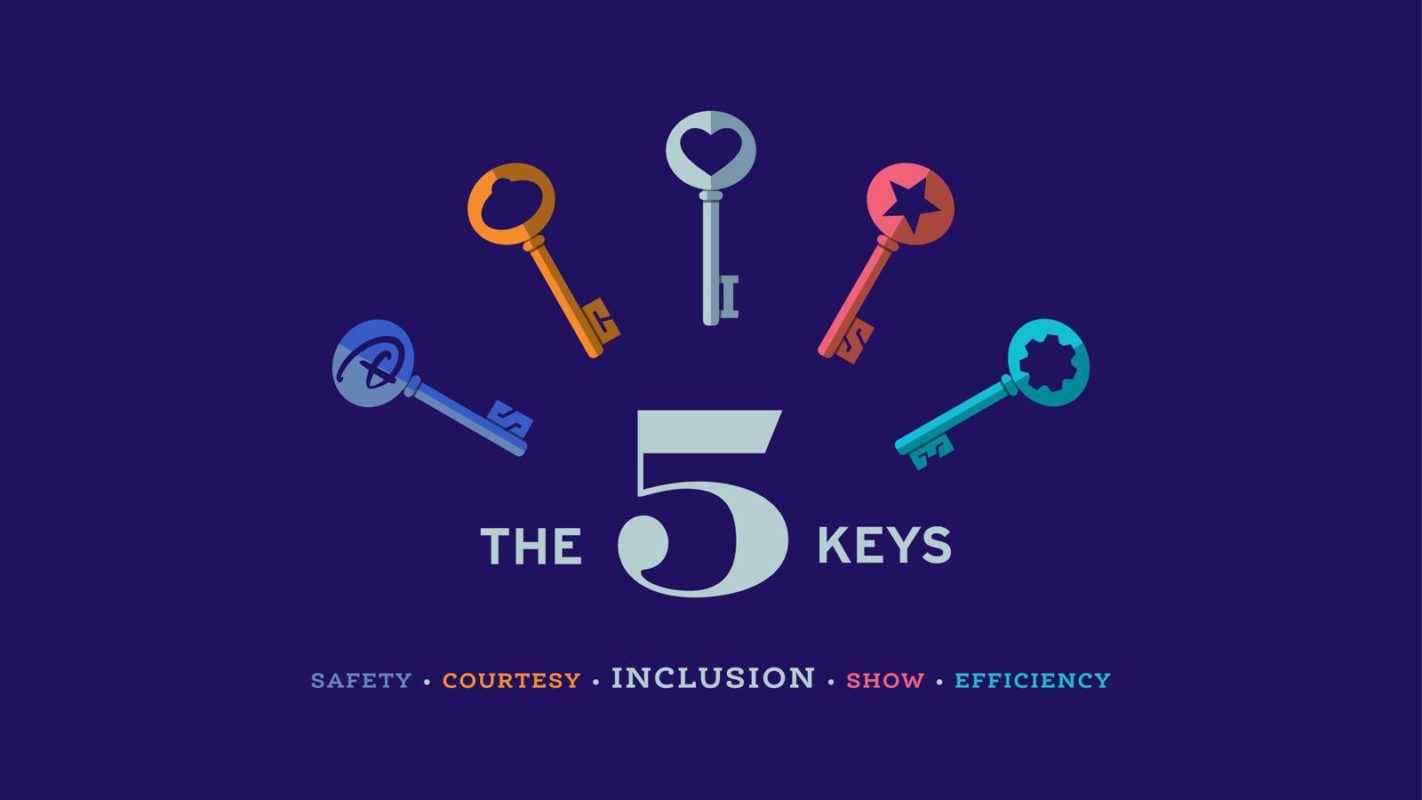
The WDC trains every cast member on these 5 keys which can be used as powerful tools when thinking strategically or working face-to-face with customers. Disney strives to create work environments that inspire optimism and present opportunities for innovation for all employees, at every level. The 5 keys support this environment as well as help to create meaningful connections with their guests as all casts use the tool when interacting at every level with both guests and each other.
Walt Disney once said, “You can dream, create, design, and build the most wonderful place in the world. But it requires people to make the dream a reality.” He knew how important it was to not only train his cast members in the mechanics of excellent customer service but to help them feel personally involved. So, when new cast members embark on their very first day of initial training, called Traditions, instead of equipping them with the technical skills they need to complete the tasks in their role, they are empowered with ‘The 5 Keys’. This is when they learn about the real goal and aim, their purpose being to create happiness and how they fit into the big picture to make it all happen.
The following two learning activities are significant to prepare you for your assessment. Please ensure that you spend some time working through the requirements.
Learning Activity: The 5 Keys
Use the internet to research ‘The 5 Keys’.
Note each one – along with what it means or represents. Post your response in the Forum, The Five Keys.
We will give you the first one:
- SAFETY
To create a safe and relaxing place, the safety of guests and cast comes before anything else. It is the primary and most important key/consideration for all cast members.
Learning Activity: Incorporating the 5 Keys
How does the WDC incorporate its mission and values (The 5 Keys) into everyday business operations? What processes are followed that demonstrate their core beliefs and values?
Re-read Disney’s mission, think about what you have learned so far about Disney’s theme parks, their attention to detail, etc., and consider how they demonstrate their values (5 Keys) in their business operations. Share your thoughts in a post to the Forum, Incorporating the Five Keys.
Carry out further research if required.
Here are some helpful links:
- http://www.olc.co.jp/en/sustainability/social/safety/scse.html (Tokyo Disney Resort)
- https://disneyexaminer.com/2016/06/06/rules-and-regulations-that-disneyland-cast-members-have-to-follow/ (Note that points 3 & 9 have been revised when the new 5th Key of Inclusion was incorporated).
- https://www.forbes.com/sites/alisondurkee/2021/04/13/disney-theme-park-employees-cast-members-can-now-have-tattoos-and-gender-inclusive-hairstyles-for-first-time-ever/?sh=477debd44818
An example might be:
Mission:
Unparalleled storytelling themes are carried through the whole experience from music, costume, and ride/attraction – exacting detail across all aspects of the theme park day to day-to-day operations.
5 Keys – Safety:
Cast members must follow best practices and all safety policy procedures in their operating role, every time to ensure the safety of everyone, both guests and staff. They must be aware of surroundings and hazards that may be present and prioritise safety over every other key value. For example, one of the jobs of Custodial cast members is to mop up spilled drinks. Rather than squatting down and using their hands to clean up, they remain standing and use their feet. This is to prevent accidents as guests, who are distracted by the Disney environment all around, may not see the cast member if they were crouching down.
Innovation
Disney is all about innovation and it’s part of the company’s foundation, it’s just what they do. Walt Disney Imagineering is the creative segment of the business that designs and builds all of Disney’s theme parks, resorts, attractions, and cruise ships worldwide. It also oversees the creative aspects of Disney games, merchandise development, and publishing business. Imagineering is a name trademarked by Disney and is formed from the words imagining and engineering and refers to engineers and designers who work together to make the magic happen. Disney prides itself on innovation and is constantly looking at ways to improve their product offerings and the guest experience.
Case Study: Technology-always part of our magic
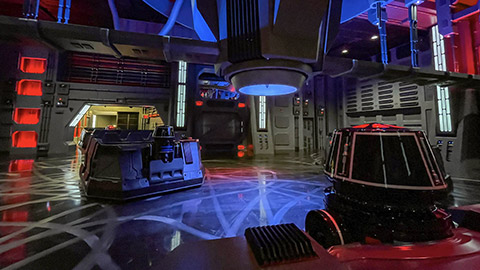
Read the following blog written by Chairman of Disney Parks, Experiences and Products, Josh D’Amaro in September 2021.
"At Disney, we’ve always pushed the boundaries of technology and innovation to entertain our guests and create experiences that are unlike anything else in the world.
Walt Disney himself was fascinated by the technology of his day, and by the possibilities it represented for the movie and theme park industries. He invented the multi-plane camera and used Technicolor in his animated films … then moved on to create Audio-Animatronics figures for Disneyland shows like “Great Moments with Mr. Lincoln” and “Walt Disney’s Enchanted Tiki Room.” That was just the beginning, and Walt’s curiosity, imagination, and ingenuity set the stage for the decades of invention and discovery that have followed.
Today at Disney Parks, Experiences, and Products, we continue to innovate by inventing and investing in technology and embracing what it can mean to a Disney experience – seamlessly integrating the physical, digital, and virtual worlds to help you navigate our properties and platforms, immerse yourself in our stories, connect with those you love and share your unforgettable experiences with the world.
Over the past few years, our Imagineers have developed amazing technology for attractions such as Star Wars: Rise of the Resistance and the Spider-Man acrobatic robot that soars above Avengers Campus in Disney California Adventure Park. You may have also caught a glimpse of what they are working on for future experiences, including a “real” lightsabre that will debut at Star Wars: Galactic Starcruiser at Walt Disney World Resort, a free-roaming Groot robotic character, or a full-sized exoskeleton that may one day bring our larger characters to life in ways you never thought possible.
Sometimes this technology takes centre stage and inspires a sense of awe, while other times it plays a supporting role, all but invisible behind the scenes … but it’s always there, helping our cast, crew, employees and Imagineers make magic. As we kick off the 50th anniversary of Walt Disney World Resort, we’re excited about the ways that technology will add to our celebration – and beyond. Today we announced a project with Amazon called “Hey, Disney!” With it, we’ve created our custom assistant, using Disney stories, characters, and more – all built on Amazon’s Alexa technology.
Whether you’re at home or in one of our Walt Disney World Resort hotel rooms, soon you’ll be able to use an Echo device to interact with your favourite Disney, Pixar or Star Wars characters. “Hey, Disney!” will make your vacation easier, more meaningful, and more fun … and it will entertain and delight you when you’re at home, too. It raises the bar for immersive storytelling with authentic character voices, unique audio environments inspired by our films and destinations, and more than a thousand magical interactions to discover – so you can expect a few surprises!
We’ll have more to share soon about “Hey, Disney!” and other ways that technology and innovation will continue to help us make magic and create the Disney Difference – setting ourselves apart in the world of dream vacations, renowned family entertainment, and innovative products and experiences around the world.
Just like Walt, all of us at Disney today think it’s kind of fun to do the impossible. Our curiosity and imagination are always working overtime, inspiring us with dreams of what could be and where we’ll go next. Technology opens new doors every day, presenting us with endless possibilities and an ever-evolving vision of the future. I hope you’ll come along for the ride – we’re just getting started."
Learning Activity: Disney and Technology
Investigate and research how Disney uses technology to transform the theme park experience. Choose one from below or find a new technical idea or project that Disney is currently working on. Explain how its function benefits the guests. See if you can include some images or even a clip. Have fun! Post your responses to the Forum, Disney & Technology.

Image credit: Disney
All businesses, irrespective of size and brand reputation, have been affected by the global COVID-19 pandemic. And sadly, Walt Disney World is no exception. During the pandemic, theme parks and resorts were forced to close, cruises were suspended, and movie production and movie theatres were closed down for months. In the first fiscal quarter of 2022, however, Disney managed to pull back and recover from its Covid losses for the first time
Below is a chart sourced from Statista.com which shows that the DPEP business in particular has rocketed back to almost pre-Covid results.

You now have learned a great deal about both the well-diversified powerhouse of the WDC, its business segments, mission, values, and its attitudes towards corporate social responsibility. Of course, we have also learned that the tourism operating environment can impact the company, in both strategic planning and its day-to-day operations.
The PESTEL framework is an excellent tool to analyse the external environment of a business. Let us break it down for you and how it can be applied to Walt Disney World.
P: Political factors - The political factors that can impact Walt Disney World include government policies on taxation, labor laws, and regulations. For instance, changes in taxes or labor laws may impact the park's operational costs, which may lead to changes in ticket prices or services offered.
E: Economic factors - Economic factors such as economic growth, inflation, and exchange rates can significantly impact Walt Disney World. For example, a recession may result in a decrease in park attendance, and it may also affect the disposable income of the park's visitors.
S: Sociocultural factors - Trends in society such as demographics, lifestyle changes, and cultural differences can significantly impact the park's operations. For instance, Walt Disney World may need to adapt to the changing lifestyles of younger generations to maintain its relevance and appeal.
T: Technological factors - Technological advancements such as automation, artificial intelligence, and virtual reality can significantly impact Walt Disney World. The park may need to invest in such technologies to enhance visitor experiences and remain competitive.
E: Environmental factors - Environmental factors such as climate change and environmental regulations.
L: Legal factors - As Disney operates in a global market, legal metrics become more relevant.
Learning Activity: PESTEL Analysis
Review and use the PESTEL framework to conduct an in-depth analysis of the potential impact of each aspect on Walt Disney World.
Use what you have learned so far, and the videos you have seen and conduct further research.
You must be specific, explaining the potential impacts with specific examples.
Also, remember to consider trends and competition in your PESTEL analysis.
Here are some prompts that you may wish to add to your planning:
- Natural disasters/weather events
- COVID-19 pandemic
- Carbon emissions, etc.
- Economic growth of developing markets and slowing of certain other markets
- Intellectual property regulation
- Local legislation
Legal:
Currently, Walt Disney World Florida operates under unique legislation that sees it operate in its zone, having its jurisdiction to control its environment. The law passed in 1967, means that Disney is responsible for controlling and paying for its own power service, fire protection, water waste management, and road systems. If this law was repealed, then the local Florida taxpayers would need to fund these costs – but Disney would need to go through local legislation every time it required permission to build/add-on and create new attractions and activities. This would seriously impact the growth of the business and the ability to keep forging ahead with new technological aspects to rides and attractions. This could result in a decrease in business as the regularity of returning guests to seek out new experiences drops.
Post your response to the Forum, PESTEL Analysis.
